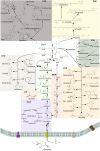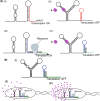Toward improved terpenoids biosynthesis: strategies to enhance the capabilities of cell factories
- PMID: 38647812
- PMCID: PMC10992668
- DOI: 10.1186/s40643-022-00493-8
Toward improved terpenoids biosynthesis: strategies to enhance the capabilities of cell factories
Abstract
Terpenoids form the most diversified class of natural products, which have gained application in the pharmaceutical, food, transportation, and fine and bulk chemical industries. Extraction from naturally occurring sources does not meet industrial demands, whereas chemical synthesis is often associated with poor enantio-selectivity, harsh working conditions, and environmental pollutions. Microbial cell factories come as a suitable replacement. However, designing efficient microbial platforms for isoprenoid synthesis is often a challenging task. This has to do with the cytotoxic effects of pathway intermediates and some end products, instability of expressed pathways, as well as high enzyme promiscuity. Also, the low enzymatic activity of some terpene synthases and prenyltransferases, and the lack of an efficient throughput system to screen improved high-performing strains are bottlenecks in strain development. Metabolic engineering and synthetic biology seek to overcome these issues through the provision of effective synthetic tools. This review sought to provide an in-depth description of novel strategies for improving cell factory performance. We focused on improving transcriptional and translational efficiencies through static and dynamic regulatory elements, enzyme engineering and high-throughput screening strategies, cellular function enhancement through chromosomal integration, metabolite tolerance, and modularization of pathways.
Keywords: Cellular tolerance; Chromosomal integration; Dynamic regulation; Modular engineering; Promoter engineering; Protein engineering; RBS engineering; Terpenoids.
© 2022. The Author(s).
Conflict of interest statement
All authors consent to publishing the manuscript in
The authors declare that they have no competing interests.
Figures






Similar articles
-
Metabolic engineering of Yarrowia lipolytica for terpenoids production: advances and perspectives.Crit Rev Biotechnol. 2022 Jun;42(4):618-633. doi: 10.1080/07388551.2021.1947183. Epub 2021 Jul 29. Crit Rev Biotechnol. 2022. PMID: 34325575 Review.
-
[Advances in the biosynthesis and metabolic regulation of terpenoids in Saccharomyces cerevisiae].Sheng Wu Gong Cheng Xue Bao. 2024 Jun 25;40(6):1661-1693. doi: 10.13345/j.cjb.230682. Sheng Wu Gong Cheng Xue Bao. 2024. PMID: 38914485 Review. Chinese.
-
Rapid and high-throughput construction of microbial cell-factories with regulatory noncoding RNAs.Biotechnol Adv. 2015 Nov 1;33(6 Pt 1):914-30. doi: 10.1016/j.biotechadv.2015.05.009. Epub 2015 May 29. Biotechnol Adv. 2015. PMID: 26027891 Review.
-
Engineering Robustness of Microbial Cell Factories.Biotechnol J. 2017 Oct;12(10). doi: 10.1002/biot.201700014. Epub 2017 Sep 18. Biotechnol J. 2017. PMID: 28857502 Review.
-
[Enzyme engineering in microbial biosynthesis of terpenoids: progress and perspectives].Sheng Wu Gong Cheng Xue Bao. 2024 Aug 25;40(8):2473-2488. doi: 10.13345/j.cjb.240165. Sheng Wu Gong Cheng Xue Bao. 2024. PMID: 39174466 Review. Chinese.
Cited by
-
Recent advances in lycopene and germacrene a biosynthesis and their role as antineoplastic drugs.World J Microbiol Biotechnol. 2024 Jun 25;40(8):254. doi: 10.1007/s11274-024-04057-0. World J Microbiol Biotechnol. 2024. PMID: 38916754 Review.
-
Biosynthesis Progress of High-Energy-Density Liquid Fuels Derived from Terpenes.Microorganisms. 2024 Mar 30;12(4):706. doi: 10.3390/microorganisms12040706. Microorganisms. 2024. PMID: 38674649 Free PMC article. Review.
-
Total Synthesis of the Diterpenes (+)-Randainin D and (+)-Barekoxide via Photoredox-Catalyzed Deoxygenative Allylation.J Am Chem Soc. 2024 Apr 15;146(16):11486-92. doi: 10.1021/jacs.4c02224. Online ahead of print. J Am Chem Soc. 2024. PMID: 38618944 Free PMC article.
-
Regiospecific C-H amination of (-)-limonene into (-)-perillamine by multi-enzymatic cascade reactions.Bioresour Bioprocess. 2022 Aug 26;9(1):88. doi: 10.1186/s40643-022-00571-x. Bioresour Bioprocess. 2022. PMID: 38647597 Free PMC article.
-
Functional bioactive compounds in ginger, turmeric, and garlic.Front Nutr. 2022 Dec 8;9:1012023. doi: 10.3389/fnut.2022.1012023. eCollection 2022. Front Nutr. 2022. PMID: 36570131 Free PMC article. Review.
References
-
- Ahmed MS, Ikram S, Rasool A, Li C. Design and construction of short synthetic terminators for β-amyrin production in Saccharomyces cerevisiae. Biochem Eng J. 2019;146:105–116. doi: 10.1016/j.bej.2019.03.011. - DOI
Publication types
Grants and funding
LinkOut - more resources
Full Text Sources

